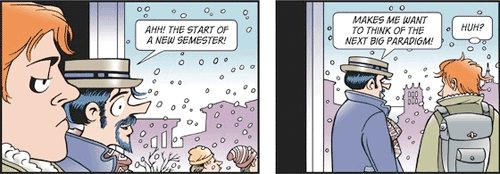My development class also has a lab. The last few weeks have all been teaching them how to get good optics on a research scope, and how to take photomicrographs with my PixeLink camera system. Today I’m going to show them how to appropriately process an image for publication, so they’ll learn a few digital enhancement tricks and a few ethical rules. I lay down a few laws about using image processing on scientific data:
What you must do to your image:
-
You must archive the original data and work with a copy. If I ask to see the original after you’ve enhanced the image up the wazoo, you better be able to show it.
-
You must document every step and every modification you make. You’re going to describe everything either on the image itself or in a figure legend; if this were to be published, you’d probably include it in the Methods section.
-
You must explain the scale and orientation of the image. The scale is usually shown by including a scale bar; orientation may be shown either by including annotations (text describing landmarks in the image) or an explanation in the figure legend, such as that it is a sagittal or horizontal section.
-
You must save the image in a lossless format, such as .png or .psd or .tiff. Do not save it in a lossy format like .jpeg, which can add compression artifacts.
What you may do to your image:
-
You may crop and rotate the image.
-
You may adjust the contrast and brightness for the whole image.
-
You may carry out simple enhancements, like applying a sharpening filter or unsharp masking, to the whole image…but remember, document everything!
-
You may splice multiple images together to produce a photomontage; you can also insert panels with enlarged or otherwise enhanced regions of the image, as long as it is absolutely clear what you’ve done.
What you may not do to your image:
-
You must not carry out selective modifications of portions of the image; you cannot sharpen the cell you care about and then reduce the contrast for other regions, for instance. You should not burn or dodge regions of the image.
-
No pixel operations or retouching: you are not allowed to go into the image and paint your data into existence!
We do a lot of this preliminary basic stuff because I run the course out of my research lab, rather than a student lab. I want to make sure they’re not going to break anything, and also that they know how to do good imaging, a skill they’ll find useful in other courses and in research (years ago when I taught this stuff, we’d also do black&white darkroom work — nobody does that any more, so now it’s all photoshop). The goal is to get them all able to churn out lovely photographic data, so later I can just hand them some nematodes or fruit fly embryos and tell them to do their own experiments and observations, just show me the pretty pictures when they’re done.
It’s a good life, being able to sit back and let students bring me gifts of biological beauty. I think they’ll also be posting some of these to their blogs.


